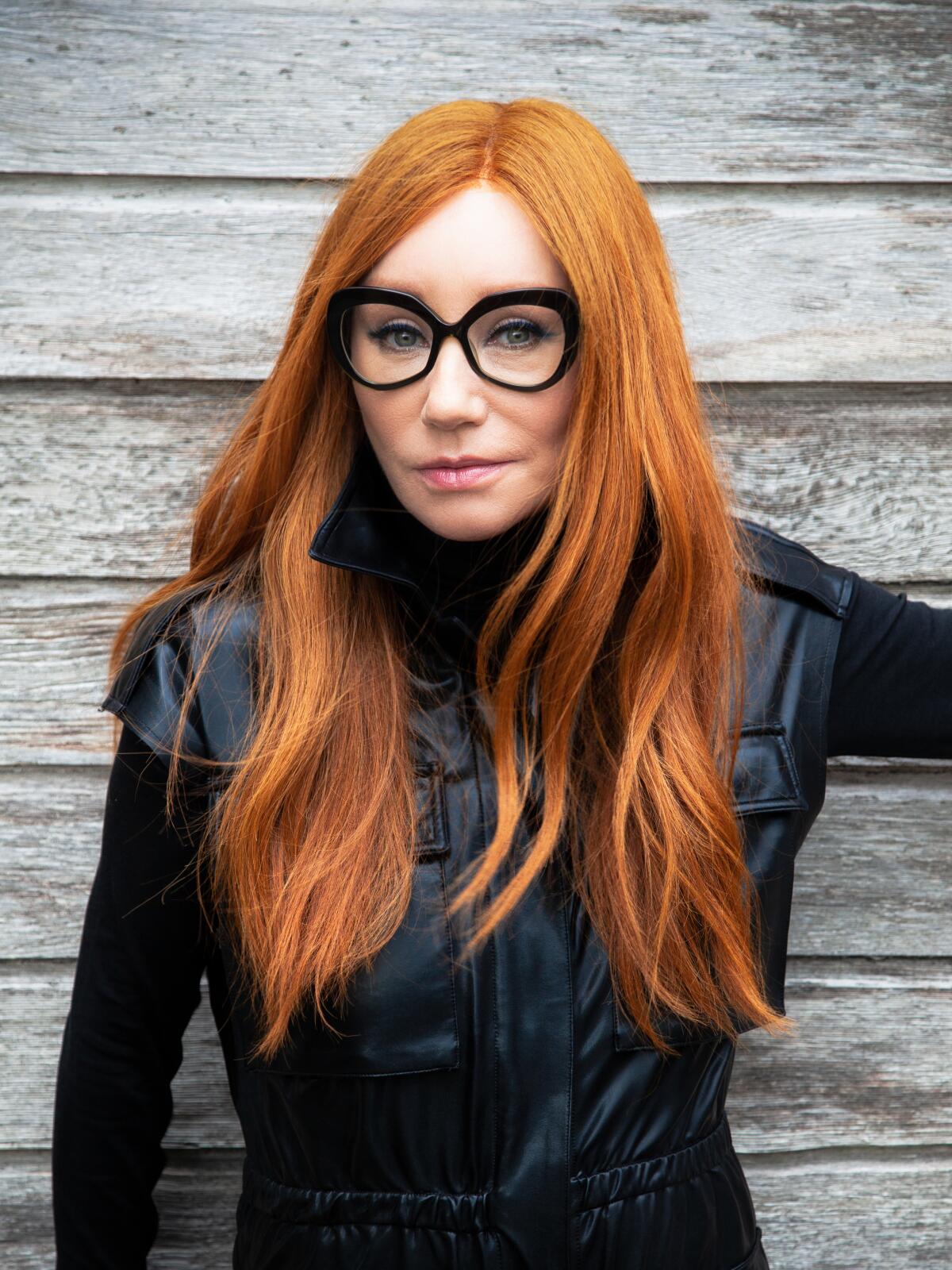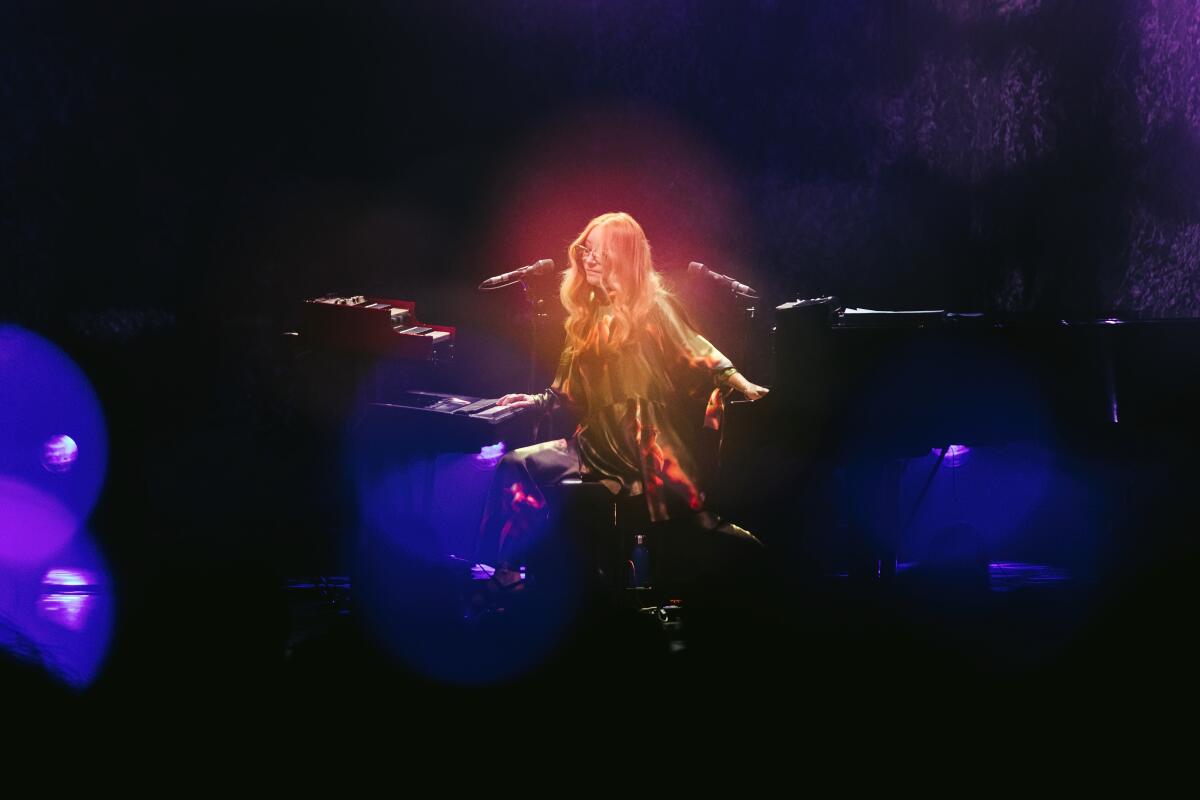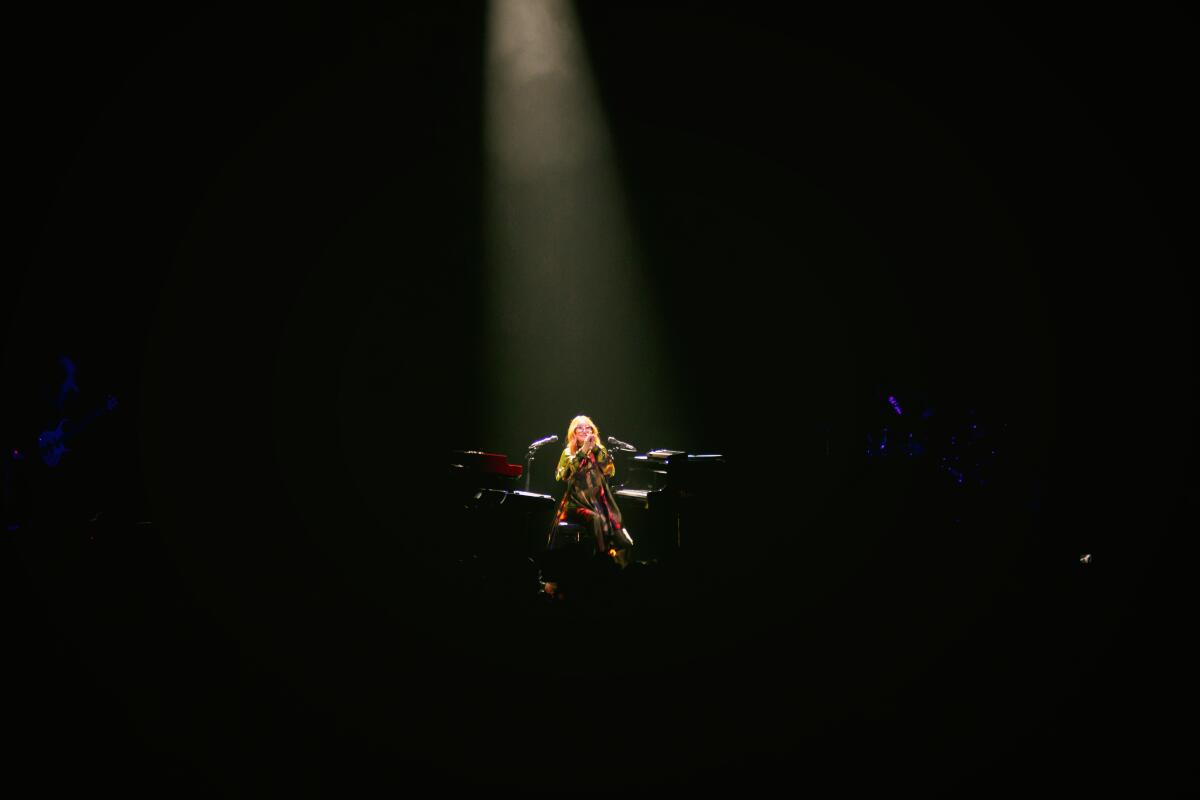The biggest entertainment stories
Get our big stories about Hollywood, film, television, music, arts, culture and more right in your inbox as soon as they publish.
You may occasionally receive promotional content from the Los Angeles Times.

When Tori Amos thinks of Los Angeles, she first recalls the distinctly manmade scent of Aqua Net hairspray.
“I’m ashamed to say it, but in those days, I had a can of Aqua Net in my handbag at all times,” says the singer-songwriter, 58. “I’d make my hair as high as I could and be ready to go.”
Hailing from a Southern Methodist family in Maryland, Amos moved to L.A. in 1984, when hair metal dominated the charts and the members of Mötley Crüe were the kings of the Sunset Strip.
She was only 5 when she began a course of study in classical piano at the Peabody Institute; yet by age 11, Amos, already corrupted by Led Zeppelin, was asked to leave the program over her reluctance to read sheet music. Her 1988 major-label debut, a work of synth-pop pastiche released sarcastically under the name “Y Kant Tori Read,” was met with scorching rejection by the press; a writer for Billboard described the record as “bimbo music.”
“In L.A., the worst disease you could get was failure,” Amos says over the phone from Rochester, N.Y., a recent stop on her first tour in more than five years. “But failure was my greatest teacher.”
From the ashes of her 1980s remained that same spirit of rebellion, which coursed passionately throughout her 1992 reinvention: a hit record titled “Little Earthquakes,” which turned 30 this year. Bolstered by the volcanic force with which Amos played piano, her unsparing, operatic reflections on trauma — from the religious shame she weathered as a girl (“Crucify”) to the brutal sexual assault she survived after performing a concert (“Me and a Gun”) — came as an alt-rock revelation to generations of outsiders, artists and provocateurs that make up her devoted fan base. (Notable “Toriphiles” include wrestler Mick Foley, Halsey and even Justin Timberlake.)

Amos returns to Los Angeles on Wednesday for the first of three shows at the Orpheum Theatre, in support of her 2021 album, “Ocean to Ocean.” A series of intimate sketches from the pandemic era, each ballad draws from Amos’ yearning for community while sheltering at home in the English seaside county of Cornwall, where she lives with her husband, sound engineer Mark Hawley, and their daughter, Natashya “Tash” Hawley. Though she relished quality time with her family, “so many of us were lost,” she says of the extended period of isolation, with nods to the police violence and political unrest in the United States.
In the absence of real-life communion with fans at her shows, Amos learned to commune with the world around her in different ways. In “Speaking With Trees” she lets nature hold her grief for the loss of her mother, who died in 2019; and in “Addition of Light Divided,” she invokes Kali, the Hindu goddess of death and transformation, to help “break this chain of pain.” In contrast to her Christian upbringing, Amos plays with a curious syncretism all her own, taking inspiration from the mythology of various cultures; in our interview, she credits her own artistic process to the Muses, daughters of the Greek god Zeus and spiritual patrons of the arts.
“I’m holding space for the Muses to come and go wherever they want to take us,” Amos says. “Even if it’s somewhere across the galaxy.”

You moved to L.A. in the ’80s, during the height of the hair-metal era. What was it like for you then?
I would play all the piano bars in town, to pay my rent. I’d do these four- or five-hour stints in these Grecian gowns, with my hair up in a bun. Then I’d change back in my car, put on black eyeliner and shake my hair so that I could hit the Sunset Strip and not look like an alien. My daughter looks at photos from back then and [asks], “Did this really happen?” I said, “It really did.” It was such a fashion car crash.
Your solo debut, “Little Earthquakes,” turned 30 this year. Upon its release in 1992, hair metal began to recede, and Nirvana entered the picture. What was it like to make a piano record during the height of the grunge-rock era?
People in the industry would say to me, “The piano thing is dead.” A famous producer suggested to the label, “The problem with ‘Little Earthquakes’ is you need to take all the pianos out and put guitars on.” Doug Morris [then president of Atlantic Records] and I had a flat-out throwdown at his office off Sunset. I had to become the gladiator.
But in the end, I have to give Doug credit: He said that if I turned in some new tracks with a very low budget, we would see what happens. So I called on my L.A. musician pals, and Eric Rosse, who was my partner at the time, to produce the demos. We turned in four songs, including “Silent All These Years,” and Doug accepted them. To be an original creator, you’ve got to be OK to stand on your own with just a few people around you who support you. The worst thing that can happen? You wake up with your self-respect.

Your confrontational, feminist approach to piano-driven music has proliferated in pop today. I hear your spirit in records by Taylor Swift, Olivia Rodrigo and especially the latest record by Halsey, which was produced by Trent Reznor, a former collaborator of yours. Do you keep up with this new wave of singer-songwriters?
What’s interesting is that I now have a 21-year old-daughter, Tash, so I learn through her. But she discovers all kinds of things, even going back into the past for things I missed before — like, she loves India.Arie. We were driving through Florida a few weeks ago, and we saw Paula Cole was on tour. Tash was like, “I want to go see her, Mom.” And I actually never met Paula Cole, until she popped backstage in Boston the other night. What a lovely woman, by the way.
In your 2020 book, “Resistance: A Songwriter’s Story of Hope, Change, and Courage,” you wrote that the “weight of processing conflict” affected the writing of “Little Earthquakes.” In listening to “Ocean to Ocean,” I think of the number of large-scale, collective conflicts we’ve all had to process: a deadly pandemic, protests, violence. Last January, we turned on our televisions and witnessed what’s now being investigated as an attempted coup in the U.S. Capitol.
We have to keep naming what we witnessed. We are not going to allow this to be diluted — what they did was treasonous. They’re not getting a pass, especially not from the ginger behind the piano. Frankly, she’s not having it.
Are we all processing it? I don’t think we are. The wounds are there but I don’t think we’re in recovery. We have to want to heal. Just being out on the road right now across the U.S., I’m trying to hold a space for people to have community. To have their own ideas about things, yes, but also to come where it’s a safe place to be emotional. I’m holding space for the Muses to come and go wherever they want to take us … even if it’s somewhere across the galaxy.
From intimate clubs to picturesque outdoor theaters to state-of-the-art arenas and stadiums, there’s no better place to see live music than SoCal.
Did you go into writing “Ocean to Ocean” with the intent for a more communal healing process than a personal catharsis?
I began first with the intention of writing myself out of my own private hell. During the first lockdown, I realized other people were experiencing that in their own ways — I know the lockdown was more severe in other parts of the world. But my husband and I, we did our little thing in the middle of nowhere. I put out my book, did a virtual book tour, turned the recording studio into a video studio. My daughter learned to do hair and makeup for me. I happened to have “Quarantina,” this wig we got because nobody could get their hair done for five months. But I hadn’t been on tour since 2017. By January [2021], with a third lockdown and an insurrection back in the States, everyone was exhausted, and it just felt like, “Is this ever going to end?”
Five years is a long time to go without being on tour. It’s also a long time to go without connecting with your fans.
This is the longest most musicians have gone without playing live in their lifetimes. Some could do a virtual concert in their living room — but I’m just singing at you from Cornwall, and maybe you’re doing something else at home in New Zealand. But there is an exchange between audience and musicians that is very sacred. Being with [a live audience], we’re just in it together. And when we’re working together, that’s where the magic and the transmutation can happen. That’s why I think so many of us were lost.

The demands on musicians have changed some during the pandemic. Now, they’re expected to share so much of themselves on social media, to the point where their mental health begins to suffer. You’ve long pushed back against the exploitation of women, especially in the music industry — but did you feel as overexposed when you were coming up?
In our time, there were more magazines, and more time between exposure. If we were getting criticized, it was usually by somebody who’s at least knowledgeable about music. A lot of those publications are gone now. It was a different kind of exposure, and it was its own shield, in that it was harder for the public to get directly to an artist. You couldn’t just … DM me. Am I using the right terminology for that? Please cover for me.
Anyway — online, you can get wonderful reinforcement, and you can get a following quite quickly on a massive scale. You don’t have to be as subservient to a label. You don’t have to go through the gatekeepers. If they don’t get it, that doesn’t mean it’s not getting a response from people online. That data is real, it changes careers. I think artists face the same pressures, but now you have to find new ways to protect yourself. And you must protect yourself.
Angel Olsen channeled the death of her parents, and her coming out, into the emotionally and musically rich album ‘Big Time.’
So how do you take care of your mind and your heart when you share it so graciously with other people?
I think the whole world could do with therapy. Sure, you want media training, but you need this. A lot of artists now don’t even start by touring and being an opener for 10 years before they really make it — they jump right in, and they don’t have the tools to deal with this level of attention. I’m grateful that I started slowly. Without that, I wouldn’t have known how to hold the stage, whether it was a small theater or Madison Square Garden in 1998.
That’s how you became the gladiator.
Yeah, yeah, yeah. But hopefully with some wisdom and a fairy wink.

The biggest entertainment stories
Get our big stories about Hollywood, film, television, music, arts, culture and more right in your inbox as soon as they publish.
You may occasionally receive promotional content from the Los Angeles Times.